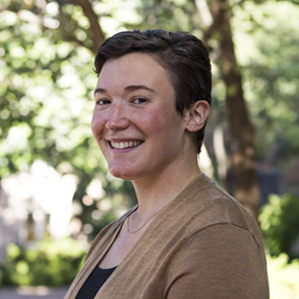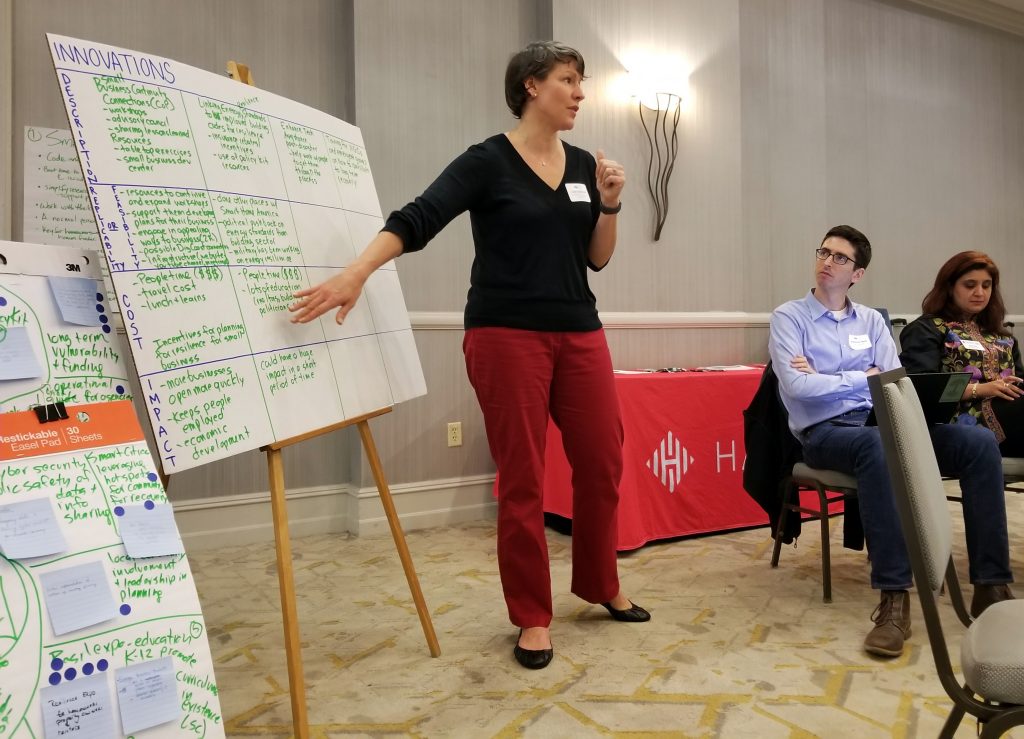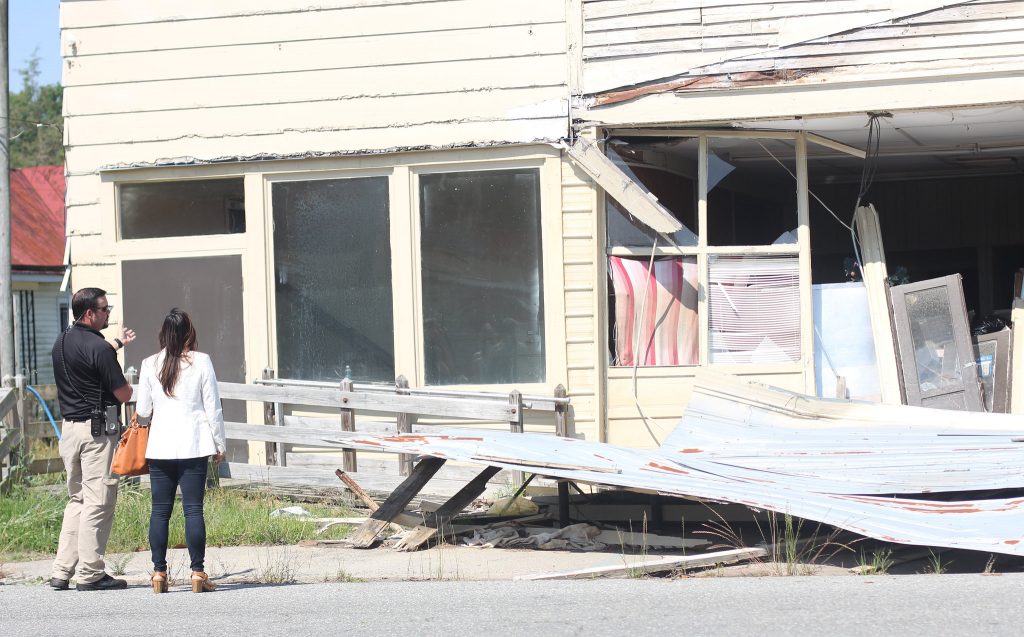Students involved in Coastal Resilience Center (CRC) projects have been key to a regional partnership that assists Southeastern states with training, resources and access to organizations that help coastal communities recover from disasters.
University of North Carolina at Chapel Hill (UNC) doctoral candidate Amanda Martin is director of the Southeast Disaster Recovery Partnership (SDRP), a program funded by the National Oceanic and Atmospheric Administration and supported by the Coastal States Stewardship Foundation and SECOORA, the Southeast Coastal and Ocean Observing Regional Association. Martin formerly worked on a housing recovery project as part of the Hurricane Matthew Disaster Recovery and Resilience Initiative (HMDRRI) led by then-Director and CRC Principal Investigator Dr. Gavin Smith.

Martin now conducts research on the role of public-private sector partnerships and leads engagement among disaster recovery practitioners at SDRP.
“As the Director and the primary staff to the Partnership, I take care of everything that needs to happen so the Partnership can continue supporting disaster recovery capacity in the region. This work includes managing our federal grant, setting strategic direction, hosting workshops, and writing white papers and policy briefs.”
SDRP staff is small – Martin is one of two employees – but Martin said SDRP relies on collaboration with local, state, federal, and private partners to provide additional expertise that supports their work, including university faculty and practitioners associated with HMDRRI. Former CRC students, including Education and Workforce Develop Grant recipient Darien Williams, have also worked at SDRP.
According to the Southeast Coastal Ocean Observing Regional Association (SECOORA), the Southeast coastal region – which includes North Carolina, South Carolina, Georgia and Florida – is particularly vulnerable to coastal hazards such as hurricanes and floods. The cost of natural disasters in the United States has roughly doubled in the last two decades, and in the Southeast region more than 17 million people live in counties adjacent to the coast.
The vulnerability of this region was recently highlighted by the impacts of Hurricane Matthew, which followed a path directly up these states’ shorelines. SDRP aims to help these regions build the resilience of both environments and economies.
“We started as a one-off, two-year grant project in 2016. In the intervening years, we have cultivated energy and commitment from our partners who want to see us sustain and grow the Partnership as an ongoing platform for exchange, learning and spin-off projects.”
Since 2016, Martin said the Partnership has marked several accomplishments, including:
- In South Carolina, public and private sector leaders from South Carolina Emergency Management and Atlantic Business Continuity Services have hosted multiple seminars on business continuity in concert with coastal chambers of commerce and local emergency management departments.
- In Georgia, the Department of Natural Resources has worked closely with local government partners and Hagerty Consulting to develop pre-disaster recovery and redevelopment plans in Glynn and Brantley counties, which are in the southeast corner of the state.
- SDRP has hosted four interactive workshops for regional recovery practitioners in each of their four target states, each time growing their reach and providing more and more opportunities to engage with leaders.
“One of the nice things about being a young initiative is that we have flexibility to respond to changing needs in the states where we work. One of our core values is to listen to the needs on the ground, rather than propose or implement solutions that might not be tailored to specific needs.”

For example, Martin said, North Carolina Emergency Management (NCEM) originally proposed to work with SDRP to create a template for a pre-disaster recovery plan, but after Hurricane Matthew hit the state in October 2016, implementing a full-scale disaster recovery effort became the top priority. SDRP and NCEM adapted their project into an opportunity to learn from the recovery process and preserve those lessons for North Carolina and other states in the future.
Martin said that each event, and each region of a state, can have unique needs post-storm.
“The biggest differences we see are in different profiles of communities that could be impacted by coastal storms – large cities have one set of needs and capacities, coastal communities another, and rural communities further inland another.”
SDRP has continued to focus more on recovery, as its years of operation coincide with a busy series of landfalling hurricanes in the region it serves.
“Disaster recovery has become more relevant than ever before. Between Matthew, Irma (2017), María (2017), Florence (2018), Michael (2018) and other flooding events, we spend less time justifying our Partnership’s mission and more time learning from the communities and leaders who are doing the actual work of recovery.”
Working with SDRP helped Martin with work she conducted as part of Hurricane Matthew recovery work led by CRC. In the summer of 2017, she and UNC professor Dr. Mai Nguyen conducted research and developed recommendations for a report on the recovery of affordable housing in Eastern North Carolina.
“It was very helpful for the study to have a sense of the key stakeholders in the state and local recoveries from leading the Partnership,” Martin said.
More information about SDRP can be found at secoora.org/sdrp.

Dissertation focuses on buyouts
While working on her Ph.D. at the Department of City and Regional Planning, Martin enrolled in a speakers series course taught by CRC PI Gavin Smith. She said she credits the course for introducing her to some important themes and figures in coastal resilience.
“Having a cohort of students that is working on hazards helped develop my critical thinking about disaster recovery, especially those students who were working on HMDRRI,” Martin said.
Leading SDRP has helped Martin “speak a language that can span multiple disciplinary frameworks in the context of disaster resilience,” she said. Her Ph.D. research focuses on how federal buyouts of homes in flood-prone areas after flooding events are intended as a hazard mitigation strategy, but have other impacts as well.
“Like programs that relocate families for other reasons, buyouts affect residential mobility, wealth-building for low-income households, neighborhood conditions, and historic preservation,” Martin said. “From my work with SDRP, I know that emergency management is very mission-oriented – so the objective of hazard mitigation naturally drives the buyout program.
“From my background as a planner, however, I approach issues from a holistic, multifaceted perspective which allows me to observe the effects of buyouts across land use, hazards and community development. Both approaches are essential. The key is to be able to foster genuine connections between the two – that’s where change can occur.”
